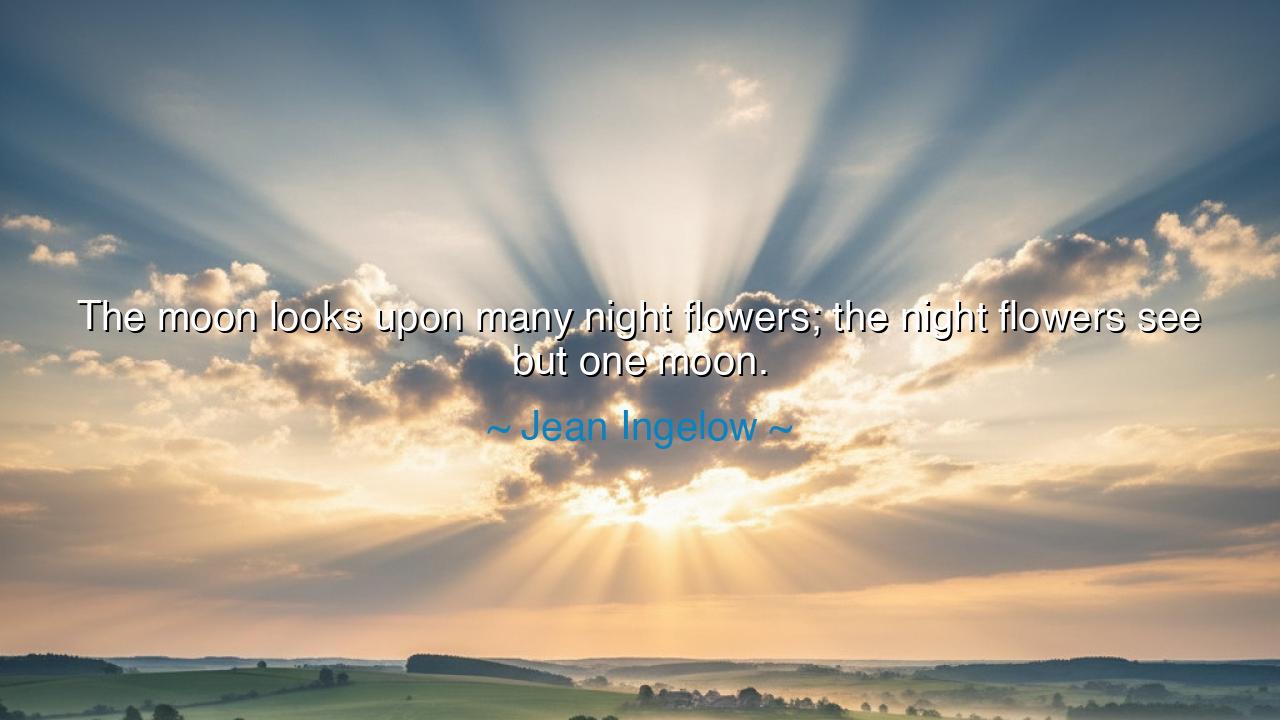
The moon looks upon many night flowers; the night flowers see






Hear these words of Jean Ingelow: “The moon looks upon many night flowers; the night flowers see but one moon.” At first glance, this utterance glimmers like a line of poetry, delicate and soft. Yet hidden within its beauty lies a profound truth about love, devotion, and the mystery of perspective. For the moon, high in the heavens, gazes upon countless blossoms that open only in the dark. To each flower, however, there is but one radiant light. The relationship is uneven, yet filled with meaning: the beloved may shine upon many, but the devoted heart sees only one.
In the language of the ancients, this image is timeless. Think of the countless mortals who have lifted their eyes to the heavens, dreaming of the moon as their companion. It shines impartially, scattering its glow upon fields, seas, and cities alike, yet every lover has believed it shines especially for them. The night flower, fragile yet steadfast, turns its face only to the single orb above. Ingelow’s words reveal both the grandeur of the universal and the intimacy of the personal: many may seek the same source of light, yet each heart experiences it as singular, unmatched, irreplaceable.
History gives us examples of such devotion. Consider Dante, whose soul was fixed upon Beatrice. To her, perhaps, he was one admirer among many, but to him, she was the singular moon that illumined his darkness. In her light he saw divine truth, in her presence he found poetry eternal. Though the world contained countless other blossoms, his heart was steadfast like the night flower, opening only to her. Such is the power of focused devotion: it transforms the ordinary into the eternal.
Yet the image also bears a sorrowful undertone. The moon, who shines upon many, cannot belong to one alone. To the night flower, this is both a gift and a trial. It must accept that its beloved light is not exclusive, that what seems intimate is, in truth, shared. Many a soul has known this feeling — to love one whose attention falls upon many. The heart aches, yet it also grows wise: love is not possession, but the reverent turning toward what gives life.
Still, let us not dwell only on longing. There is also great strength in the constancy of the night flower. It does not scatter its gaze; it does not chase many stars; it turns only to the one source that brings it bloom. Its singular devotion is its nobility. In this, Ingelow teaches us the value of focus — to choose that which truly sustains us, and to remain faithful. In a world of countless distractions, to fix one’s soul upon a guiding light is an act of courage.
The lesson, therefore, is twofold. To the ones who shine like the moon, remember your responsibility: many look to you, but each feels you as their only light. Do not scatter your radiance thoughtlessly. To the ones who bloom like the night flowers, be steadfast, but also wise: your devotion ennobles you, but know the nature of the one you love. Do not confuse shared light with diminished worth. The moon loses nothing by shining upon many, nor do you lose by being one among those who see it.
As a practical action, seek in your own life the balance of the moon and the night flower. If you are one who inspires many, let your influence be tender, mindful, and just. If you are one who follows a guiding light, let your devotion be steady but not blind. Turn your gaze toward that which uplifts your spirit, whether a person, a calling, or a truth, and let it draw forth your fullest bloom.
Thus, remember Ingelow’s teaching: life is filled with countless blossoms and countless lights, yet the bond between the moon and the night flower is eternal in its meaning. It is the story of love given and love received, of light shared and light cherished. And in that quiet exchange, the world learns what it means to be both vast and intimate, both many and one.






AAdministratorAdministrator
Welcome, honored guests. Please leave a comment, we will respond soon